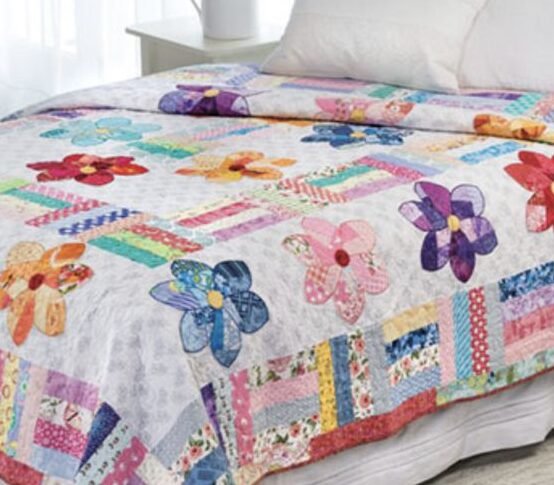Patchwork quilting, with its rich history and intricate designs, has long been cherished as a form of artistic expression and storytelling.
Among the myriad of quilt patterns, the Grandmother’s Flower Garden stands out as an enduring favorite, admired for its timeless beauty and symbolism.
In this article, we delve into the history, significance, construction, and variations of the Grandmother’s Flower Garden quilt pattern, celebrating its legacy as a beloved piece of textile art.

Origins and History
The Grandmother’s Flower Garden quilt pattern has deep roots in quilting traditions, particularly in the United States during the 19th century.
Originally known as “Mosaic Patchwork,” this pattern gained popularity for its intricate floral motifs and geometric precision. While the exact origins of the pattern are difficult to trace, it is believed to have evolved from earlier European quilting techniques, such as English paper piecing.
The name “Grandmother’s Flower Garden” emerged as a homage to the matriarchs who skillfully crafted these quilts, often passing down their knowledge and techniques through generations.
The hexagonal shapes representing flowers evoke a sense of nostalgia and connection to the natural world, reminiscent of the gardens tended by grandmothers past.
Throughout history, the Grandmother’s Flower Garden pattern has been a staple in quilting communities, cherished for its visual appeal and technical complexity.
Its enduring popularity speaks to its timeless charm and the enduring legacy of traditional quilting practices.


Symbolism and Meaning
Beyond its aesthetic appeal, the Grandmother’s Flower Garden quilt pattern carries deep symbolism and meaning. Each hexagonal “flower” represents a petal, meticulously arranged to form a vibrant garden landscape.
The act of piecing together these flowers symbolizes the interconnectedness of family and community, with each stitch holding memories and stories woven into the fabric.
For many quilters, creating a Grandmother’s Flower Garden quilt is a labor of love, honoring the legacy of those who came before while also celebrating personal connections and experiences.
The choice of colors and fabrics can hold significance, reflecting personal preferences, cultural heritage, or symbolic meaning.
In addition to its familial symbolism, the Grandmother’s Flower Garden pattern is often associated with themes of resilience, perseverance, and renewal.
Like the blooming flowers in a garden, the quilt represents growth and transformation, offering comfort and beauty in times of challenge and change.

Construction Techniques
The construction of a Grandmother’s Flower Garden quilt requires precision, patience, and attention to detail.
While there are variations in technique, the traditional method involves English paper piecing, a hand-sewing technique that allows for precise alignment and smooth seams.
To begin, quilters cut hexagonal fabric pieces, often using templates made of paper or cardboard.
These hexagons are then basted to the paper templates, creating a stable foundation for sewing. Using a whipstitch or ladder stitch, quilters sew the hexagons together, forming flower motifs.
As the flowers take shape, quilters carefully arrange them into larger panels or rows, experimenting with color placement and design.
Green fabric hexagons are often added to create “leaves” between the flowers, enhancing the garden-like effect.
Once the quilt top is complete, quilters add batting and backing layers before quilting the layers together.
Quilting patterns can range from simple to intricate, adding texture and dimension to the finished quilt. Finally, a binding is added to frame the quilt and complete the project.

Variations and Contemporary Interpretations
While the traditional Grandmother’s Flower Garden quilt pattern follows a specific layout and color scheme, contemporary quilters have embraced the pattern’s versatility and adaptability.
Modern interpretations of the pattern often incorporate bold colors, unconventional fabrics, and innovative design elements, resulting in quilts that are both timeless and contemporary.
Some quilters experiment with scale, enlarging the hexagons or playing with proportion to create a unique look.
Others combine the Grandmother’s Flower Garden pattern with modern quilting techniques, such as improvisational piecing or appliqué, to add a fresh twist to the classic design.
Additionally, the Grandmother’s Flower Garden pattern has inspired a wide range of quilting projects beyond traditional bed quilts.
From wall hangings and table runners to pillows and tote bags, the floral motif lends itself to endless creative possibilities.
In recent years, online communities and social media platforms have provided a platform for quilters to share their interpretations of the Grandmother’s Flower Garden pattern, fostering inspiration and collaboration among makers worldwide.
The Grandmother’s Flower Garden quilt pattern endures as a beloved symbol of tradition, craftsmanship, and creativity in the world of quilting.

From its humble origins to its contemporary interpretations, this timeless pattern continues to captivate quilters and enthusiasts alike, inviting them to embark on a journey of exploration and expression through fabric and thread.
Whether crafted as a cherished heirloom, a thoughtful gift, or a personal creative endeavor, the Grandmother’s Flower Garden quilt pattern holds a special place in the hearts of quilters, connecting generations and communities through the art of quilting.
EXPLORE THE BEST QUILT PATTERNS FOR INSPIRATION!
As we stitch together each hexagon, we honor the past, celebrate the present, and sow the seeds of inspiration for future generations of quilters to come.




